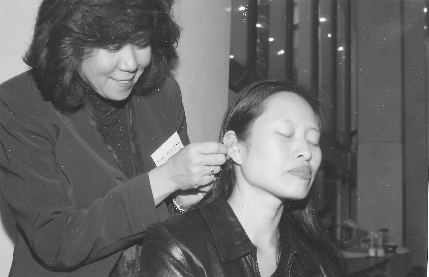By Ellen Keohane
In a sunny room on the second floor of the American Legion on Canal St. about 20 people sat in folding chairs, some with their eyes closed, listening to ambient music played on a nearby boom box. Photographs of veterans lined the walls of the room above a floor of red, white and blue tiles. “Breathe out,” said Frances Wong as she slowly inserted the first of five thin, stainless steel needles into one woman’s right ear.
Every Wednesday afternoon, Wong, who is director of Asian Services at St. Vincent’s Hospital, helps run a free ear acupuncture clinic at 191-193 Canal St. from 12:30 p.m. until 3:30 p.m. Over the course of the three-hour period, as many as 60 or so people come and go.
Saint Vincent’s World Trade Center Healing Services first started offering various stress management services including ear acupuncture following 9/11. After starting an ear acupuncture clinic at the Chinese Consolidated Benevolent Association center in 2003, the clinic moved to its current space at the American Legion in February 2005. The program is primarily funded by a grant from the American Red Cross and one of the goals is to help combat the high suicide rate of Asian Americans.
Acupuncture can decrease anxiety, improve sleep and promote relaxation, said Wong, who has a background in social work and psychotherapy, in addition to being trained in ear acupuncture. A University of Arizona study found that acupuncture can also be an effective treatment for depression. “It helps your body balance and recover, and help heal itself,” she said.
Depression among Chinese immigrants often goes undiagnosed, said Kin Wah Lee, a member of New York Coalition for Asian American Health and director of last month’s conference, “Break the Silence: Assessment and Prevention of Suicide Among Asian Americans.” Many do not know where to go for help. They lack opportunities to earn a decent living and many undocumented Chinese immigrants do not have health insurance, Lee said.
Although white, middle-aged males have the highest suicide rate, Asian Americans have a higher suicide rate than the other ethnic minorities in New York City, Lee said. According to the New York State Office of Mental Health, Asian-American women have the highest suicide rate of all women over 65 and Asian Americans/Pacific Islanders are the least likely to seek mental health treatment. Unfortunately there are no specific statistics on Chinese Americans.
Since January Lee has counted 14 media reports of suicides in New York City’s Chinese community, she said. Seven of the 14 involved people jumping from buildings in Chinatown and Flushing, Queens. Because these suicides were extremely public, Lee suspects many more have gone unreported. “I don’t have a lot of statistics,” she said.
Because ear acupuncture uses tools, techniques and methods that are part of traditional Chinese culture, it is a more accepted treatment for depression and other mental health problems, Wong said. In the Chinese community, there’s a social stigma associated with mental illness, she said. “It’s considered a shame upon your whole family and your ancestors,” Wong said.
In contrast, there’s no stigma associated with acupuncture, Wong said. Because ear acupuncture is simpler and less invasive than other forms of acupuncture, it can take place in a group setting, thereby creating a comfortable environment where people might be more willing to open up about their feelings.
It’s hard for many people in the Chinese community to admit they may have a mental health problem, and even harder for them to seek help for it, Wong said. The ear acupuncture essentially gets them in the door, where Wong can then direct them toward doctors and other mental health professionals.
“I come every week,” said Betty, 76, who would not give her last name. After her husband died, Betty couldn’t sleep and subsequently lost 25 pounds. “I was completely out of myself,” she said. Betty, who is from Taiwan, used to take Ambien every night to help her sleep, but after starting ear acupuncture in April, she no longer takes the pills.
Acupuncture was first developed in ancient China more than 3,000 years ago to prevent and treat illness, and relieve pain. It is usually performed with hair-thin, flexible stainless steel needles that are inserted into precise points on the surface of the body. Ear acupuncture, which is simpler and less invasive than other forms of acupuncture, was first used by French and Chinese physicians about 60 years ago. It is offered in five points in the ear — each point affects the balance of the body, Wong said.
Although the needles pinch when first inserted, ear acupuncture is not painful. However, after a 30 to 40-minute treatment, your outer ears may tingle for a few hours.
About 10 new people—of all races and ages—come to the ear acupuncture clinic in Chinatown every week, Wong said. “I think there are a lot of people out there who are depressed and want help,” she said.
“It calms you down completely,” said Ariel Blondet Jr., a 41-year-old train operator for the M.T.A. who paused to talk after an ear acupuncture session. It was Blondet’s eighth visit to the free ear acupuncture clinic, which he learned about while watching Queens public access channel. “I must be the least stressed transit employee they have,” he said.
google_ad_client = “pub-6226499064891091”;
google_ad_width = 468;
google_ad_height = 60;
google_ad_format = “468x60_as”;
google_ad_channel =”0606561524″;
google_color_border = “336699”;
google_color_bg = “FFFFFF”;
google_color_link = “0000FF”;
google_color_url = “008000”;
google_color_text = “000000”;
//–>
src=”https://pagead2.googlesyndication.com/pagead/show_ads.js”>
WWW Downtown Express



























